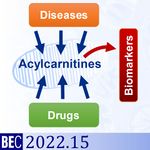Difference between revisions of "Template:BioblastAlert2024"
Tindle Lisa (talk | contribs) |
Tindle Lisa (talk | contribs) |
||
| Line 28: | Line 28: | ||
| width="110" align="center" | [[File:MitoPedia.jpg|left|80px|MitoPedia|link=MitoPedia]] | | width="110" align="center" | [[File:MitoPedia.jpg|left|80px|MitoPedia|link=MitoPedia]] | ||
|''' What is the limitation of State 3 respiration compared to OXPHOS capacity? '''<br> | |''' What is the limitation of State 3 respiration compared to OXPHOS capacity? '''<br> | ||
OXPHOS capacity is defined as the maximal respiratory capacity in the OXPHOS state in the presence of kinetically-saturating concentration of ADP, P<sub>i</sub>, fuel substrates and O<sub>2</sub>. However, State 3 as defined by Chance and Williams (1955) can lead to underestimation of OXPHOS capacity and overestimation of | OXPHOS capacity is defined as the maximal respiratory capacity in the OXPHOS state in the presence of kinetically-saturating concentration of ADP, P<sub>i</sub>, fuel substrates and O<sub>2</sub>. However, State 3 as defined by Chance and Williams (1955) can lead to underestimation of OXPHOS capacity and overestimation of ''E-P'' excess capacity due to kinetic limitations of the phosphorylation system. <br> | ||
- »'''[[OXPHOS capacity]]'''«, »'''[[ | - »'''[[OXPHOS capacity]]'''«, »'''[[E-P excess capacity]]'''« -<br> | ||
-'''[[BEC_2020.1_doi10.26124bec2020-0001.v1|Gnaiger - MitoEAGLE Task Group (2020) Mitochondrial physiology - Table 3]]'''« | -'''[[BEC_2020.1_doi10.26124bec2020-0001.v1|Gnaiger - MitoEAGLE Task Group (2020) Mitochondrial physiology - Table 3]]'''« | ||
|} | |} | ||
Latest revision as of 16:33, 6 March 2024
Bioblast alert 2024(03) - Respiratory states: 2024-03-06
Here is a system of terms and abbreviations for mitochondrial respiratory pathway and coupling control states.
Although states and rates are distinguished by different symbols for coupling control states, such a distinction is not suggested for pathway control states and rates to avoid handing and overwhelming number of different symbols.
- »MitoPedia: Pathway and coupling control states«
Do you know the difference between uncoupled, noncoupled and dyscoupled respiration?
Noncoupled respiration is induced experimentally for evaluation of ET capacity, while uncoupling and dyscoupling are respectively caused by physiological and pathological conditions that exert an influence on proton leak and slip.
- »Noncoupled respiration«, »BEC 2020.01«

What is ROUTINE respiration?
ROUTINE respiration is the respiratory activity of living (non-permeabilized) cells in the physiological coupling state, which is controlled by cellular energy demand, energy turnover and the degree of coupling to phosphorylation.
- »Gnaiger 2020 BEC MitoPathways - Chapter 2.4«
What is the limitation of State 3 respiration compared to OXPHOS capacity?
OXPHOS capacity is defined as the maximal respiratory capacity in the OXPHOS state in the presence of kinetically-saturating concentration of ADP, Pi, fuel substrates and O2. However, State 3 as defined by Chance and Williams (1955) can lead to underestimation of OXPHOS capacity and overestimation of E-P excess capacity due to kinetic limitations of the phosphorylation system.
- »OXPHOS capacity«, »E-P excess capacity« -
-Gnaiger - MitoEAGLE Task Group (2020) Mitochondrial physiology - Table 3«
Bioblast alert 2024(02) - Bioenergetics Communications and EBEC2024: 2024-02-15
The tale of two “best-friends,” proteins BID & MTCH2, pivotal regulators of the apoptosis and metabolism programs at the mitochondria.
- Gross A, (2024) A BID-MTCH2 love story: Energizing mitochondria until apoptosis do them part? Bioenerg Commun 2024.1. https://doi.org/10.26124/bec:2024-0001

EBEC2024 What is Life? Spotlights on Mito and Chlora:
Cutting-edge research on mitochondria & chloroplasts, metabolism, and disease
2024 August 26-31, Innsbruck, Austria
- »Registration and abstract submission open«

Rewarded Open Access - compensating authors..
Together with the MiPsociety, BEC is raising funds to reward the first 10 papers accepted for publication in BEC in 2024: 600 EUR to attend EBEC2024 and 2-year MiPmembership. -»Support open access in science«
- »Submit a manuscript«
Bioblast alert 2024(01) - Fatty acid oxidation: 2024-02-08
Measuring fatty acid oxidation (FAO)-linked respiration requires a low concentration of malate
In the absence of malate, accumulation of Acetyl-CoA inhibits FAO.
- »Fatty acid oxidation pathway control state«, »Mitochondrial Pathways: Chapter 5«
- communicated by »Cecatto Cristiane« and »Cardoso Luiza«

"The capacity of FA oxidative phosphorylation (F-OXPHOS) with palmitoylcarnitine was up to 4 times higher than respiration with octanoylcarnitine. The optimal concentration of palmitoylcarnitine was 10 μM which corresponds to the total concentration of LC acylcarnitines in the brain."
- Cecatto C, Cardoso LHD, Ozola M, Korzh S, Zvejniece L, Gukalova B, Doerrier C, Dambrova M, Gnaiger E, Makrecka-Kuka M, Liepinsh E (2023) Fatty acid β-oxidation in brain mitochondria: Insights from high-resolution respirometry in mouse, rat and Drosophila brain, ischemia and aging models. MitoFit Preprints 2023.10. https://doi.org/10.26124/mitofit:2023-0010
- from the O2k-Network »AT Innsbruck Oroboros« and »LV Riga Liepins E«

"... several graphical representations of the electron transfer system depict FADH2 in the mitochondrial matrix as a substrate to be oxidized by CII. This leads to the false conclusion that FADH2 from the β-oxidation cycle in fatty acid oxidation feeds electrons into CII. In reality, dehydrogenases of fatty acid oxidation channel electrons to the Q-junction but not through CII."
- Gnaiger E (2024) Complex II ambiguities ― FADH2 in the electron transfer system. »Bioblast link«
- from the O2k-Network »AT Innsbruck Oroboros«
"Clinically approved cardiovascular and diabetes drugs reduce LC acylcarnitine concentrations in vivo and it would be worth investigating whether these compounds could be repurposed."
- Dambrova M, Cecatto C, Vilskersts R, Liepinsh E (2022) Mitochondrial metabolites acylcarnitines: therapeutic potential and drug targets. Bioenerg Commun 2022.15. https://doi.org/10.26124/bec:2022-0015
- from the O2k-Network »AT Innsbruck Oroboros« and »LV Riga Liepins E«


